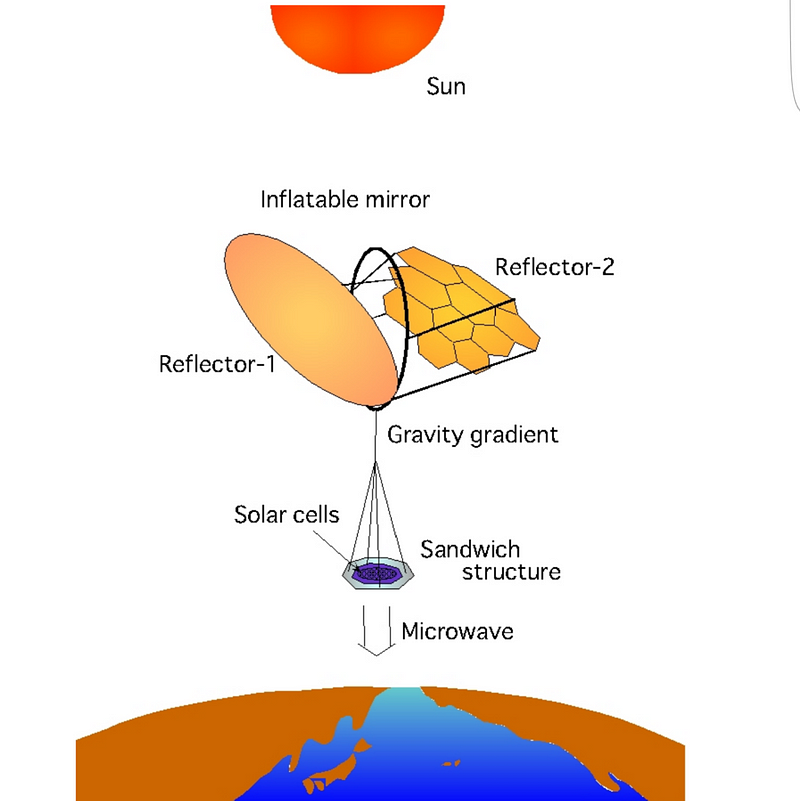Innovative Solar Solutions: Space-Based Power for a Greener Future
Written on
The Vision for 2100
Imagine a future in the year 2100 where fossil fuels are a thing of the past. Enormous megastructures orbit the Earth, capturing solar energy and transmitting it across the globe—from the icy tundras of Siberia to the sun-soaked expanses of the Sahara. The struggle for oil and gas has ceased, leading to a revitalized climate with stable weather patterns, and wildlife, such as polar bears, thriving once again.
To grasp the urgency of our current energy predicament, it's crucial to assess our present circumstances.
According to a United Nations report on sustainable energy, 13% of the global population still lacks access to modern electricity. Meanwhile, population growth continues to heighten the demand for fossil fuels at an unsustainable pace. The natural formation of oil occurs far more slowly than its extraction, with estimates suggesting we have just over fifty years before current reserves run dry.
The energy crisis is highlighted by several alarming statistics:
- The world consumes approximately 160,000 TWh of energy each year.
- Over 60% of this energy is generated from fossil fuels.
- The pollution resulting from fossil fuel consumption accelerates climate change at an alarming rate.
- By 2050, the global population is projected to reach 9.7 billion, increasing energy consumption by 50%.
Given these pressing challenges, it is clear that we urgently require cleaner, greener, and more sustainable energy sources to safeguard our planet from the dire consequences of climate change.
Introducing Space-Based Solar Power (SBSP)
SBSP, initially envisioned by Russian scientist Konstantin Tsiolkovsky in the 1920s, proposes deploying large solar panels in orbit to collect and transmit solar energy back to Earth. The National Space Service asserts that SBSP could surpass all other energy sources combined, including emerging nuclear fusion technologies.
While the use of traditional solar energy has expanded, it still faces significant limitations. Solar panels are only effective during daylight hours and are affected by seasonal variations. Currently, solar energy contributes merely 1.7% to global energy production.
The advantages of SBSP include:
- Continuous solar exposure: It's always solar noon in space, unlike Earth-based panels that are limited by daylight and weather conditions.
- Enhanced sunlight intensity: Solar panels in space avoid atmospheric interferences such as gases, clouds, and dust.
- Constant energy generation: Unlike terrestrial panels that collect solar energy for only 29% of the day, space-based panels can operate 24/7.
- Rapid energy distribution: Power can be redirected quickly to areas in need.
The Mechanism Behind SBSP
The method of harnessing solar energy in space is straightforward. Reflectors or inflatable mirrors channel solar energy onto solar panels, converting it into electricity. This electricity is then transformed into electromagnetic radiation and microwaves for wireless transmission to Earth.
Receiving antennas, known as rectennas, are strategically placed worldwide to convert these electromagnetic beams back into electricity. As solar satellites orbit, they can beam energy to various locations.

Despite the potential of SBSP, the significant distance over which electromagnetic beams must travel presents a challenge, as energy loss is a concern. Researchers from the Japanese Aerospace Exploration Agency are developing innovative designs to maximize energy transmission efficiency.
The Path Forward for SBSP
Historically, the high initial costs have hindered the development of SBSP. However, recent technological advancements are paving the way for new possibilities. Companies like SpaceX and Blue Origin are reducing the costs of orbital deliveries, making SBSP a more achievable goal.
The European Space Agency has recently committed to funding SBSP initiatives to foster clean energy production, exploring various strategies to lower development costs. With advancements in technology making launches more affordable, the time has come to focus on key technologies that will demonstrate the feasibility of solar power satellites.
One promising concept involves deploying a swarm of smaller satellites that can connect to form a large solar panel. Additionally, innovative manufacturing techniques, such as 3D printing lightweight solar cells, can significantly decrease launching costs. Researchers at the California Institute of Technology have showcased a modular power station design with thousands of ultralight solar cells, weighing only 280 grams per square meter.
China is currently leading the SBSP race with its Omega system, set to become operational by 2050. Although specific details remain undisclosed, Omega aims to deliver 2GW of power to the Earth’s grid at peak capacity, a feat that would require over six million Earth-based solar panels to match.
The Promise of Space-Based Solar Power
Given the current trajectory, the development of SBSP is not just a possibility but a necessity. The prospects of this technology are incredibly promising, with ongoing efforts likely to yield significant results. It is reasonable to believe we are moving towards a future that is not only energy-sufficient but also more prosperous.
The first video, "How space-based solar power can save the planet," discusses the transformative potential of solar energy collected in space and its implications for global energy solutions.
The second video, "How Space-Based Solar Power Could Help Solve The World's Energy Crisis," explores the critical role SBSP could play in addressing our escalating energy demands.